Jump to Section
What is Diabetic Retinopathy?
Diabetic retinopathy happens when high blood sugar damages blood vessels in the retina. When these blood vessels are damaged, they can leak fluid or bleed. This causes the retina to swell and form deposits. This is an early form of diabetic retinopathy called non-proliferative or background retinopathy.
In a later stage, called proliferative retinopathy, new blood vessels grow on the surface of the retina. These new blood vessels can lead to serious vision problems because they can break and bleed into the vitreous; the clear, jelly-like substance that fills the center of the eye. Proliferative retinopathy is a much more serious form and can lead to blindness.
Diabetic retinopathy generally does not develop in diabetics until they have had diabetes for at least 10 years, but you should not wait that long to have an eye exam. As soon as you’ve been diagnosed with diabetes, it’s essential to have a dilated eye exam at least once a year.
Symptoms of Diabetic Retinopathy
Most diabetic patients have absolutely no symptoms of retinopathy damage until it’s too late and permanent vision loss has occurred. That is why a yearly dilated exam is important. Your ophthalmologist can see changes in your retina and warn you to make changes in your blood sugar before the damage is done. Once bleeding or permanent changes occur, you may begin to experience floaters, blurriness, or missing spots in your vision.
Diagnosing Diabetic Retinopathy
The best and most common way eye doctors can diagnose diabetes is through a dilated eye exam, which allows them to look directly at the retina. Photos taken of the back of the retina are also used to document changes in the retina.
Diabetic retinopathy is characterized by proliferative and non-proliferative. Non-proliferative retinopathy is the earliest form. It can be diagnosed by a dilated eye exam and is characterized by swelling in the blood vessels, signaling that the blood vessels are not healthy. It’s a warning sign of more severe problems. Proliferative retinopathy is the more severe type of retinopathy and is characterized by new blood vessel growth forming in the retina. These new blood vessels are very fragile and can easily leak blood into the eye, causing permanent vision loss.
OUR PROVIDERS
Our team of eye doctors includes some of the foremost experts in laser vision correction and eye surgery in the greater Boston area. We look forward to helping you maintain healthy and clear vision for years to come. Learn more about our leading providers and the high level of service you can expect at the Nielsen Eye Center.
MEET OUR TEAM
Facts About Diabetes and the Eyes
- Diabetic retinopathy is the leading cause of blindness in working-age Americans.
- Usually, by the time diabetic patients recognize symptoms in their vision, the damage is severe, and many times irreversible.
- Having diabetes for a long time increases the chance of diabetic retinopathy.
- Almost all patients who have had diabetes for more than 30 years show signs of diabetic retinopathy.
- Diabetic retinopathy damage is permanent.
- Smoking and high blood pressure increase the chances of diabetic retinopathy.
- The best measure to prevent diabetes damage in the eye is by keeping blood sugars low and controlled and having yearly dilated eye exams.
- Diabetic retinopathy almost always affects both eyes.
- If you have diabetic retinopathy, you may need an eye exam more often. People with proliferative retinopathy can reduce their risk of blindness by 95 percent with timely treatment and appropriate follow-up care.
- Many cases of diabetes are diagnosed through a dilated eye exam.
Request a Diabetic Retinopathy Consultation
To schedule your yearly diabetic eye exam at the Nielsen Eye Center, please call our Quincy, MA locations or contact us through our online form.
Frequently Asked Questions
Can Eye Damage From Diabetes Be Treated?
Laser and medication treatments are available that can help diabetic retinopathy from getting worse. However, no treatment reverses the damage.
Do Elevated Blood Sugars Cause Blurry Vision?
This is usually temporary. Once blood sugars are decreased, your vision will clear up. However, prolonged elevated sugars can cause retinopathy (new blood growth and bleeding) in the eye which causes permanent damage.
Are Those Who Have Type I or Type II Diabetes More Susceptible to Damage?
Those who have had diabetes for a long time are more susceptible to diabetes damage – therefore, those who have type I diabetes typically have more damage than those with type II.
I Already Have Permanent Vision Loss. Is There Any Hope?
Much research is being done to develop drugs that would help to slow down the progression of diabetic retinopathy. Lasers and medications are also in development that would help to treat retinopathy. Also, researchers are seeking better ways to detect, treat, and prevent vision loss in people with diabetes.
If you already have permanent vision loss, then a low vision specialist can help direct you to equipment that helps magnify and better utilize existing vision. It’s essential to continue to have yearly dilated eye exams as well as keep blood sugar under control to help preserve any remaining vision.
DISCOVER OUR CONVENIENT
LOCATIONS NEAR BOSTON, MA
Schedule your appointment today at one of our four convenient offices situated on the South Shore. Serving the greater Boston area, our locations in Quincy, Weymouth, Norwell, and Norwood are here to provide exceptional eye care tailored to your needs.







